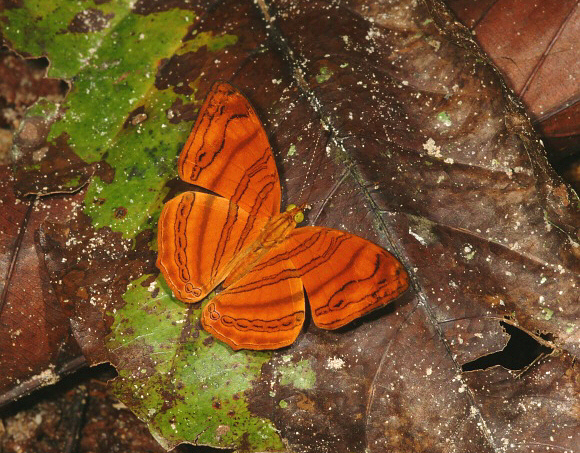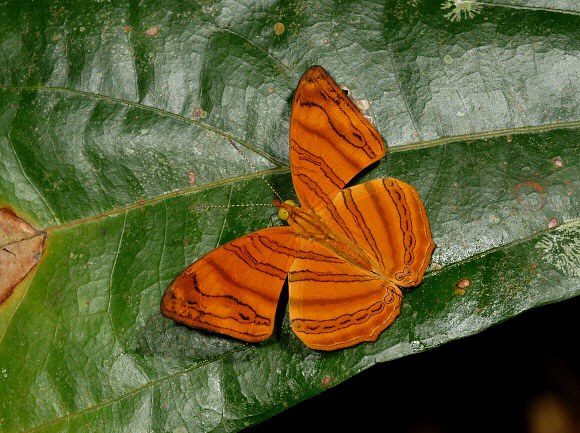
Introduction
The tiny Maplet butterflies are amongst the most delightful and interesting rainforest species found in Malaysia, delicately marked with fine wavy lines on a bright orange ground colour.
There are 7 members of the genus Chersonesia, all endemic to the Oriental region. They are very closely related to the Cyrestis Mapwings, as can be seen by comparing Chersonesia rahria with the much larger but otherwise virtually identical Cyrestis thyonneus.
Both sexes of rahria are similarly patterned, but the female is slightly paler, with broader and more rounded wings. The pattern is repeated on the underside of the wings in more subtle hues.
Chersonesia rahria, in common with most other members of it’s genus is widespread throughout the Oriental region, being found in West Malaysia, Sumatra, Borneo, Java, Palawan and Sulawesi.

Habitats
This species breeds in primary rainforest at elevations between 0-800m. At higher altitudes it is gradually replaced by C. risa, in which the outer lines on the forewings are straight rather than wavy.
Lifecycle
The yellowish-green egg is dome-shaped with eleven prominent vertical ridges. It is laid singly at the edge of a leaf of the climbing fig Ficus aurantiacea ( and probably other Ficus species ).
Prior to hatching the larva nibbles an almost complete circular channel out of the upper part of the eggshell, thereby creating a trapdoor which it pushes up and out of the way as it emerges.
When small the larva rests on the underside of a leaf, at the tip. It nibbles chunks from either side, and sits on the remaining projecting midrib, pointing inwards, using it as a retreat. At this stage of its life it often decorates its body with its own droppings, possibly because the acrid smell deters ants or parasitoid wasps.
When older the larva has a habit of biting part way through the midrib. The most likely explanation for this is that the sap contains toxins, and that severing the ‘artery’ prevents these from reaching the part which the caterpillar chooses to eat.
The fully grown larva is pale green with oblique stripes of darker green. It is described by Corbet & Pendlebury as being cylindrical and smooth-skinned, “with a pair of long filamentous processes on the 2nd and 8th abdominal segments, the former curved backwards, and the latter forwards, and both serrated on the posterior edge”. The brown head also bears a pair of recurved horns.
The brown chrysalis resembles a small dead leaf. Like the larva, it has a pair of curved horns on the head. There is a small thorn-like projection on the thorax, and a dorsal keel projecting from the abdomen. It is suspended by the cremaster from a leaf or twig.
Adult behaviour
The Chersonesia Maplets are dainty little butterflies which flit regularly from spot to spot, but never stray far from their favoured places. They will often perch momentarily on the underside of a leaf before fluttering daintily to another leaf nearby, on which they settle with wings fully outspread and held flat against the surface. At other times they like to land on the ground, usually on wet leaf litter, and will spend long periods probing among the rotting vegetation, at all times keeping their wings outspread.
The butterflies are commonest in the wet season, and will fly in light rain, although they are much more active in hot sunny weather conditions, at which time they can be found in wet parts of the forest, flying in places where dappled sunlight filters through the trees.
I have never seen either sex visit flowers – both sexes seem to obtain their sustenance either from mineralised moisture on the ground, or from aphid secretions ( and possibly bird droppings ) on the surface of leaves. It is notable however that the closely related Cyrestis Mapwings often visit fungi, and while I have never seen them doing so, Chersonesia are quite likely to behave similarly.
Unlike most butterflies which roost with their wings held erect, Maplets hide overnight or on rainy days beneath leaves, with their wings fully outspread – another feature they share with their relatives in the genus Cyrestis.
